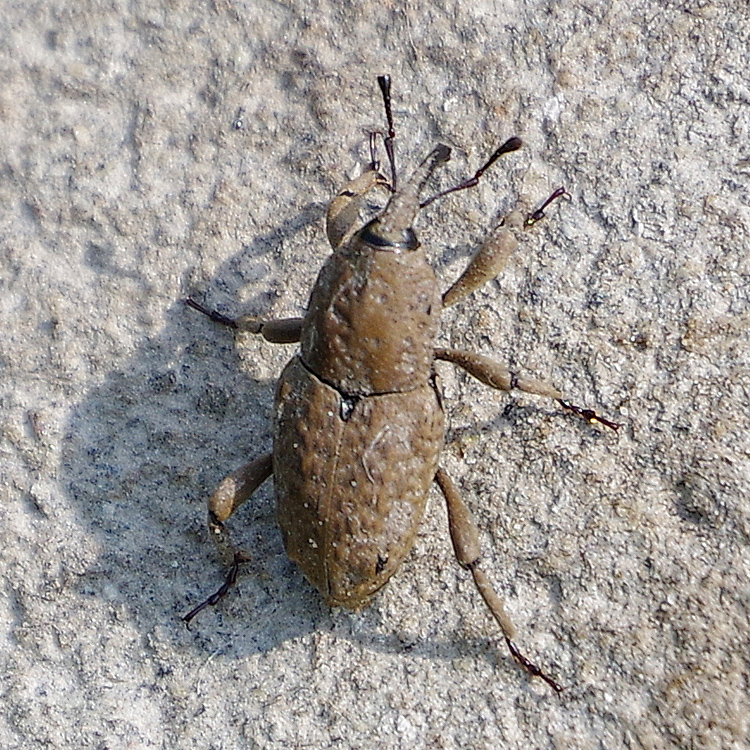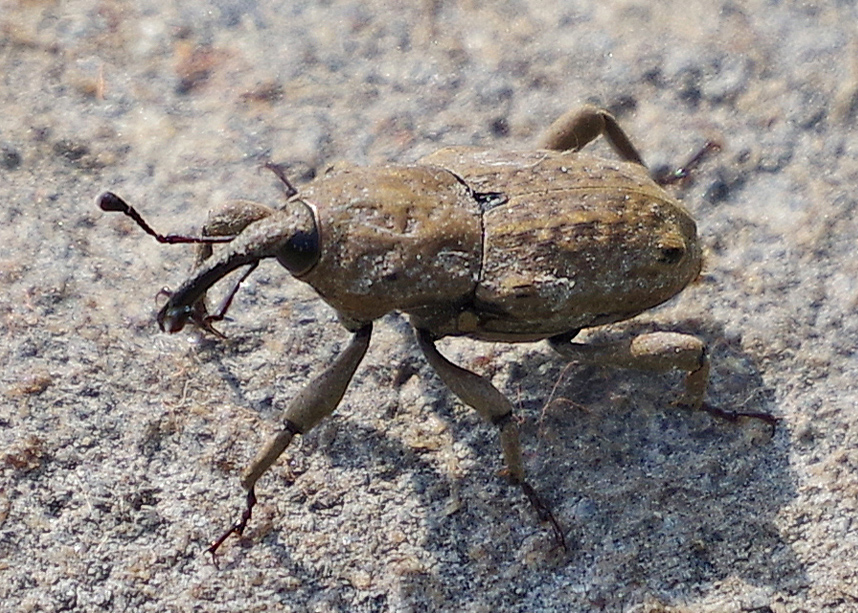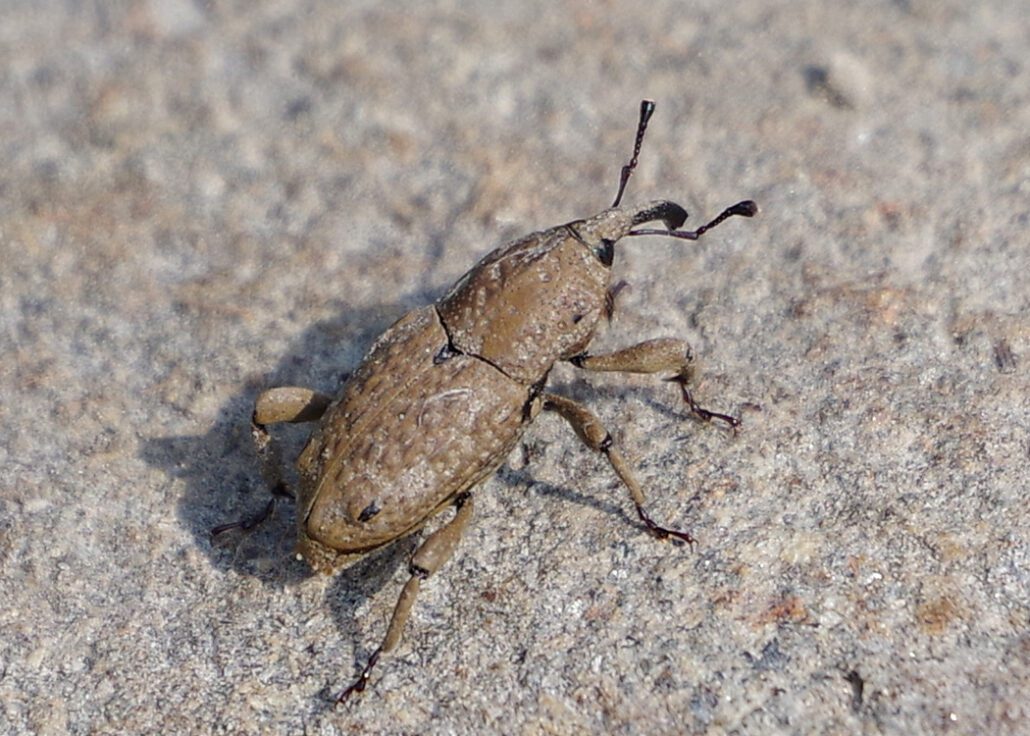
by Kate Redmond
Bug o’the Week Southern Corn Billbug
Greetings, BugFans,
As Seasoned BugFans know, the BugLady is a fan of weevils – she loves the cut of their tiny jibs (for “jibs” read “snouts”) (for “snouts” read “rostrums”). Snouts tipped with chewing mouthparts and adorned with clubbed and elbowed antennae https://bugguide.net/node/view/1038921/bgimage, snouts long and slender https://bugguide.net/node/view/2308802/bgimage, and snouts short and stout https://bugguide.net/node/view/2003970/bgimage, https://bugguide.net/node/view/1959459/bgpage. So she was excited to find a Southern corn billbug while she was in a park on the Milwaukee River – an odd spot, but you’re never far from a corn field in Wisconsin.
Who are the billbugs? They are members of the beetle order Coleoptera, the largest order in the whole animal kingdom with about 390,000 described species (the Coleoptera account for about 40% of all insect species), and of the beetle family Curculionidae (the bark and snout beetles), the largest family in the whole animal kingdom, with 50,000 species worldwide. As British biologist J.B.S. Haldane (may have) said, the Creator had “an inordinate fondness for beetles.” Billbugs, so-named for their curved snouts, are weevils in the genus Sphenophorus (from the Greek for “wedge-bearer”), with 65 species in North America and more elsewhere.
As a group, Billbugs are persona non grata because of the habit of many species, mainly in the larval stage, of feeding on members of the grass family. Billbugs tend to be pedestrians – they’ve been observed in flight, but not very high and not for very long (and with a tailwind), and their larvae are legless, which means that they don’t disperse quickly.
Despite their name, SOUTHERN CORN BILLBUGS(Sphenophorus callosus) are notably absent from much of the South https://bugguide.net/node/view/278604/data. The North Carolina University Extension describes their range thus: “the Coastal Plain of the Carolinas and Georgia. However, this pest damages corn over the entire Coastal Plain of the southern states and up the Mississippi River valley into the Midwest.” Their name doesn’t seem to set off any alarms with University Extension offices here in Wisconsin.


Southern corn billbugs are a little more than one-third of an inch long and are a little lumpy-looking. Some are brownish in color https://bugguide.net/node/view/1933001/bgimage, and they often carry a coating of dust or dirt. Here’s a glamour shot – https://bugguide.net/node/view/77598/bgimage.
While many billbugs go for turfgrass and some attack rice, Southern corn billbugs specialize in corn (rice and corn are members of the grass family). It’s a one-two punch – the larvae feed at the base of the plant, and the adults feed higher up, and the “jaws” at the ends of the adults’ snouts allow them to reach into the inner tissues of the stem. Adults like several other plants, like sorghum (another grass), and they especially like Yellow nut sedge, aka Chufa, a maybe-native-maybe-not sedge that’s considered an invasive agricultural weed (click on any picture for a slide show https://www.minnesotawildflowers.info/grass-sedge-rush/yellow-nutsedge).
Southern corn billbugs overwinter as adults in leaf litter or barely underground, often in ditches and hedgerows near corn fields. They emerge as the young corn emerges and trek into the field (they also float well), and they’re more likely to be found in corn plants around the periphery of a field than the interior.
Females lay eggs toward the base of the corn stem, in holes they made while feeding. When the larvae hatch (just one per stem, but there may be as many as five in a stem if billbugs are thick on the ground), they move down the outside of the stem and feed in the roots and then bore into the lower stalk. Needless to say, this makes it hard for the young plant to thrive. They pupate in cells in the corn stalk or root, or in the soil. Newly-minted adults may emerge to feed before tucking in for the winter, or they may hunker down until spring.
Rotating crops keeps billbug numbers down, and farmers who practice continuous no-till agriculture have higher infestations. One potential biological control is (Science Word of the Week) entomopathogenic nematodes. Nematodes are small roundworms that are, according to Britannica, “among the most abundant animals on earth.” Nematodes are – well – everywhere (https://uwm.edu/field-station/bug-of-the-week/nematodes-for-poets/). Entomopathogenic (pronounced just like it looks) means that the nematodes are able to cause disease in the billbug larvae or other insects they encounter.
According to the University of Florida’s Featured Creatures page on the topic, “Entomopathogenic nematodes occur naturally in soil environments and locate their host in response to carbon dioxide, vibration and other chemical cues.” A nematode carrying symbiotic bacteria (bacteria that it lives peaceably with) enters the larva’s body cavity and bacteria are released there. The bacteria multiply, the larva dies, and the nematode feeds, matures, and reproduces within.
The BugLady can’t recall if she’s shared this dynamite article about the decline of insects. Great graphics! https://www.reuters.com/graphics/GLOBAL-ENVIRONMENT/INSECT-APOCALYPSE/egpbykdxjvq/
Kate Redmond, The BugLady
Bug of the Week archives:
http://uwm.edu/field-station/category/bug-of-the-week/
